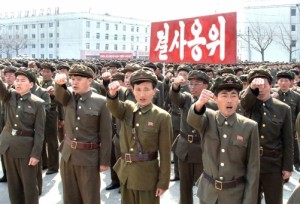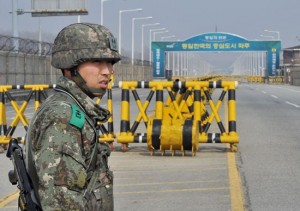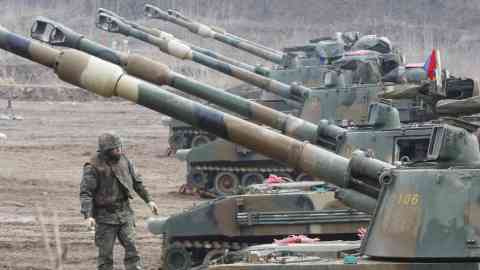South Korea is bracing for a protracted standoff with the North that could include at least one missile test-launch and a border skirmish. Should the rest of the world be bracing for war as well?
 On Friday, North Korea attempted to heighten fears of military conflict when it told embassies in its capital, Pyongyang, that it could not guarantee the safety of their staff in the event of war. In another sign that it is determined to increase the pressure, Pyongyang extended a ban preventing South Korean officials from entering the Kaesong industrial complex – which it operates jointly with the South – for a fourth day.
On Friday, North Korea attempted to heighten fears of military conflict when it told embassies in its capital, Pyongyang, that it could not guarantee the safety of their staff in the event of war. In another sign that it is determined to increase the pressure, Pyongyang extended a ban preventing South Korean officials from entering the Kaesong industrial complex – which it operates jointly with the South – for a fourth day.
A government official in Seoul said there was no indication of an exodus of foreign diplomats from the North, despite the warning. “We don’t believe there’s any foreign mission about to leave Pyongyang,” the official told the Yonhap news agency. “Most foreign governments view the North Korean message as a way of ratcheting up tension.”
The message to embassies came as US officials confirmed media reports that North Korea had moved two medium-range missiles to its east coast. The Musudan missiles, with a range of 1,865 miles, are capable of striking South Korea, Japan and US bases in the Pacific. Possible launches are expected to be tests rather than targeted strikes, and may be timed to coincide with the 101st anniversary of the birth of North Korea’s founding father, Kim Il-sung, on 15 April.
In response, South Korea has sent Aegis destroyers equipped with advanced radar systems to both of its coasts. The US had earlier said it would speed up the deployment of missile defence systems to Guam, a US Pacific territory whose military bases Pyongyang has identified as targets. Officials in Washington offered a measured response to confirmation that the North had mounted two missiles on mobile launchers. “We’ve obviously seen the reports that North Korea may be making preparations to launch a missile and we’re monitoring this situation closely,” the White House press secretary Jay Carney said. “And we would not be surprised to see them take such an action. It would fit their current pattern of bellicose, unhelpful and unconstructive rhetoric and actions.”
US attempts to lower the diplomatic temperature come after a prolonged display of its naval and air power in the region  during joint military exercises with South Korea. Pyongyang has condemned the annual drills, which run to the end of the month, as preparations for an invasion.
during joint military exercises with South Korea. Pyongyang has condemned the annual drills, which run to the end of the month, as preparations for an invasion.
The North Korean media continued to describe the standoff in dramatic terms at the weekend, accusing the US and South Korea of “waging madcap nuclear war manoeuvres”.
“This is aimed at igniting a nuclear war against it through a pre-emptive strike,” the Minju Joson, a government daily newspaper, said. “The prevailing situation proves that a new war, a nuclear war, is imminent on the peninsula.”
The prospect of a North Korean missile test is causing concern in Japan, which is easily within range. In Tokyo, Yoshihide Suga, a government spokesman, said that Japan was preparing for a “worst-case” scenario, and urged China and Russia to play “significant roles” in defusing tensions. Experts and officials have dismissed Pyongyang’s threats to launch nuclear strikes against the US, given the rudimentary state of its weapons capability. But it could cause widespread disruption with a cyberattack, according to a defector who worked for the regime’s 3,000-member cyberwarfare unit.
The regime’s next move could be to break into US computer networks to steal information and spread viruses, Jang Se-yul, who defected to the South in 2008, told the Observer. North Korea’s hackers are suspected of being behind recent cyberattacks that paralysed computer networks at several South Korean banks and broadcasters.
“It would demonstrate that North Korea is a strong cyberpower,” Jang said. “Their prime target is the US, and they’ve been preparing for something like this for years, including when I was there in the 1990s. I can’t say how successful they would be, but it’s a possibility.”
The barrage of threats have failed to unnerve people in Seoul, just 54km from the demilitarised zone – the strip of heavily guarded land that has separated the two states since they agreed on a ceasefire, but not a peace treaty, at the end of the 1950-53 Korean war. Streets were packed with cars and shoppers as usual on Saturday, despite rain and chilly weather.
The South Korean media have also been measured in their coverage. When North Korea vowed last week to restart its nuclear reactor at Yongbyon, South Korean newspapers devoted more space to government plans to grant tax breaks to home buyers. On Naver, the country’s most popular web portal, the most read news item last week was about Ryu Hyun-jin, a South Korean baseball pitcher who made his debut for the LA Dodgers. The relaxed mood would quickly change in the event of a localised attack on a South Korean military asset or one of the frontline islands near the disputed maritime border.
Last week the South’s new president, Park Geun-hye, said that the military would hit back hard if provoked. Her predecessor, Lee Myung-bak, was criticised for his slow response to attacks in 2010 on a naval ship and island, in which 50 people died.
An editorial in the Korea Times said those living in both the North and South had reason to be vigilant. “Not a single expert can say for sure what will be the unpredictable regime’s next move,” the newspaper said. “One thing seems certain, however: it will be Koreans, especially South Koreans, who will have to shoulder the risks of any misjudgment or miscalculation to be made by either Koreas.” There was consternation, too, that the North had disrupted operations at Kaesong for four days, although it has not closed the facility. Last week it prevented South Korean workers from crossing the border into the complex, located just inside North Korea. About 100 South Koreans who had stayed at Kaesong last week were due to return yesterday, with 500 more remaining.
The Korea Herald noted that the £56bn that the North earns from the complex every year was “no small amount”, adding that the country “does not have many comparable or better sources of hard currency”.
Political tensions have briefly disrupted operations at Kaesong several times since it opened in 2004, but a complete and prolonged shutdown would be a sign that cross-border ties were near to collapse.
“South Korea takes this situation very seriously,” a senior government official in Seoul told the Observer. “We must watch even the smallest moves by North Korea. At the same time, we will continue to send signals that we want to build trust with Pyongyang in the hope that it will cooperate and dialogue can begin.”
By Justin McCurry in Seoul

